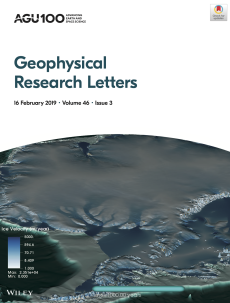Vulnerability of the Antarctic Ice Sheet
Simulations Probe Antarctic Vulnerability to Regional Ice Shelf Collapse

Journal cover: visualization of the retreated Antarctic Ice Sheet 1000 years after the collapse of the Ronne Ice Shelf in the Weddell Sea. The ice surface is colored with ice velocities in blue. Underlying bedrock is shown in brown (above sea level) and green (below sea level). This image is a single frame from the movie available at: https://drive.google.com/open? id=18DwuRHx1QGGq3CfGlQFBPjDAiw6yfLu (full set of movies available at: https://drive.google.com/drive/folders/1aPvMSfB9imlNzlHinUn4wlgKmESpj2vL? usp=sharing)
Science Achievement
A team led from Berkeley Lab used a highly-resolved model of the Antarctic Ice Sheet to systematically examine vulnerability to regional collapse of its floating ice shelves and the resulting potential for large contributions to sea level rise (SLR).The biggest uncertainty in near‐future sea level rise (SLR) comes from the Antarctic Ice Sheet. Antarctic ice flows in relatively fast‐moving ice streams from the interior to the ocean, where it is carried into enormous floating ice shelves which push back on their feeder ice streams, buttressing them and slowing their flow. Melting and loss of ice shelves due to climate change can result in faster ice flow, ice sheet thinning and retreat, and a resulting accelerated contribution to global sea level rise.
Impact
This is the first fully-resolved, systematic study of millennial-scale ice sheet response to regional ice shelf collapse based on all major Antarctic drainage basins. We found that sustained ice-shelf loss in any of the Amundsen Sea, Ronne, or Ross sectors can lead to wholesale West Antarctic ungrounding and collapse. However, even with unrealistically extreme forcing, loss is relatively modest for the initial century, increasing markedly afterward in West Antarctic collapse scenarios. Finally, our results indicate that Antarctic drainage basins are dynamically independent for 1-2 centuries, after which dynamic interactions between basins become increasingly important (and regional modeling results will be increasingly inaccurate).
Research Details
To better understand where the Antarctic ice sheet is vulnerable to ice‐shelf loss, we divided it into 14 sectors, which roughly correspond to large-scale Antarctic drainage basins. We applied extreme thinning rates to each sector's floating ice shelves in turn while running the high-resolution BISICLES ice flow model 1000 years into the future for each case. We found three levels of vulnerability. The greatest vulnerability came from attacking any of the three ice shelves connected to West Antarctica, where much of the ice sits on bedrock below sea level. Each of those dramatic responses contributed around 2m of sea level rise. The second level came from four other sectors, each with a contribution between 0.5‐1m. The remaining sectors produced little to no contribution. We also examined combinations of sectors, determining that sectors behave independently of each other for at least a century.
This work, entailing 35,000 years of Antarctic simulations, was enabled by the combination of DOE SciDAC-funded BISICLES ice sheet model (part of the ProSPect partnership) and NERSC’s computational resources. BISICLES uses adaptive mesh refinement (AMR) to deploy sufficient (~1km or finer) model resolution where needed to resolve grounding-line dynamics.
Related Links
1. Martin, D.F., S.L. Cornford, and A.J Payne. (2019), “Millennial‐scale Vulnerability of the Antarctic Ice Sheet to Regional Ice Shelf Collapse”, Geophysical Research Letters, 46, https://doi.org/10.1029/2018GL081229
2. DOE SciDAC ProSPect:
https://doe-prospect.github.io/
3. BISICLES model description paper: https://www.sciencedirect.com/science/article/pii/S0021999112005050?via=ihub
4. BISICLES model highlight flyer:
https://e3sm.org/wp-content/uploads/2018/08/ResearchHighlight_BISICLES.pdf
About NERSC and Berkeley Lab
The National Energy Research Scientific Computing Center (NERSC) is a U.S. Department of Energy Office of Science User Facility that serves as the primary high performance computing center for scientific research sponsored by the Office of Science. Located at Lawrence Berkeley National Laboratory, NERSC serves almost 10,000 scientists at national laboratories and universities researching a wide range of problems in climate, fusion energy, materials science, physics, chemistry, computational biology, and other disciplines. Berkeley Lab is a DOE national laboratory located in Berkeley, California. It conducts unclassified scientific research and is managed by the University of California for the U.S. Department of Energy. »Learn more about computing sciences at Berkeley Lab.







